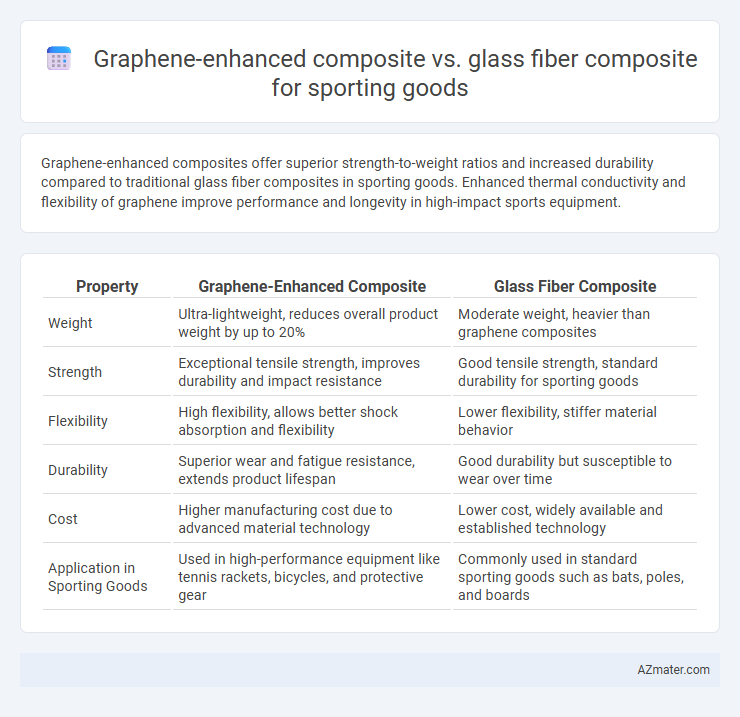Graphene-enhanced composites offer superior strength-to-weight ratios and increased durability compared to traditional glass fiber composites in sporting goods. Enhanced thermal conductivity and flexibility of graphene improve performance and longevity in high-impact sports equipment.
Table of Comparison
| Property | Graphene-Enhanced Composite | Glass Fiber Composite |
|---|---|---|
| Weight | Ultra-lightweight, reduces overall product weight by up to 20% | Moderate weight, heavier than graphene composites |
| Strength | Exceptional tensile strength, improves durability and impact resistance | Good tensile strength, standard durability for sporting goods |
| Flexibility | High flexibility, allows better shock absorption and flexibility | Lower flexibility, stiffer material behavior |
| Durability | Superior wear and fatigue resistance, extends product lifespan | Good durability but susceptible to wear over time |
| Cost | Higher manufacturing cost due to advanced material technology | Lower cost, widely available and established technology |
| Application in Sporting Goods | Used in high-performance equipment like tennis rackets, bicycles, and protective gear | Commonly used in standard sporting goods such as bats, poles, and boards |
Introduction to Advanced Sporting Good Materials
Graphene-enhanced composites offer superior strength-to-weight ratios and enhanced durability compared to traditional glass fiber composites, making them ideal for high-performance sporting goods. These advanced materials provide improved impact resistance and flexibility, which contribute to better athlete safety and equipment longevity. The integration of graphene transforms sporting equipment by elevating performance metrics beyond those achievable with conventional glass fiber composites.
Overview of Graphene-Enhanced Composites
Graphene-enhanced composites in sporting goods offer superior strength-to-weight ratios compared to traditional glass fiber composites, leveraging graphene's exceptional tensile strength and electrical conductivity. These composites provide enhanced durability, impact resistance, and flexibility, improving overall performance in equipment like tennis rackets, bicycles, and protective gear. The integration of graphene also contributes to reduced material fatigue and extended product lifespan, making it a cutting-edge alternative to conventional glass fiber materials.
Fundamentals of Glass Fiber Composites
Glass fiber composites consist of fine glass fibers embedded in a resin matrix, providing high tensile strength, durability, and cost-effectiveness for sporting goods like tennis rackets and helmets. These composites offer excellent impact resistance and stiffness while maintaining lightweight characteristics essential for performance equipment. Glass fiber's isotropic properties and ease of fabrication make it a fundamental material choice in sporting goods manufacturing, although these factors limit its strength-to-weight ratio compared to graphene-enhanced composites.
Mechanical Strength Comparison
Graphene-enhanced composites exhibit superior mechanical strength compared to glass fiber composites, offering higher tensile strength and improved impact resistance critical for sporting goods' performance and durability. The integration of graphene significantly enhances stiffness and fatigue resistance, enabling lighter yet stronger equipment that withstands rigorous use. Advanced graphene composites provide enhanced energy absorption and deformation tolerance, outperforming traditional glass fiber materials in demanding athletic applications.
Weight and Durability Analysis
Graphene-enhanced composites exhibit significantly higher strength-to-weight ratios than traditional glass fiber composites, offering superior lightweight properties essential for high-performance sporting goods. The incorporation of graphene improves durability by enhancing tensile strength and resistance to wear and impact, resulting in longer-lasting equipment under rigorous use. Compared to glass fiber composites, graphene composites enable manufacturers to produce lighter gear without compromising structural integrity, optimizing athlete performance and endurance.
Flexibility and Performance Enhancement
Graphene-enhanced composites exhibit superior flexibility and performance enhancement compared to traditional glass fiber composites in sporting goods, offering increased tensile strength and resilience while maintaining lightweight characteristics. The integration of graphene nanomaterials significantly improves energy absorption and impact resistance, resulting in enhanced durability and responsive flex during use. This advanced material composition allows athletes to achieve better control and power transfer, elevating overall performance on the field or court.
Manufacturing Process Differences
Graphene-enhanced composites feature a manufacturing process that integrates graphene nanoplatelets or sheets into the polymer matrix through advanced dispersion techniques such as ultrasonic mixing or shear mixing, enhancing mechanical properties and reducing weight. Glass fiber composites undergo a more traditional process involving the layering of woven glass fibers with resin, typically utilizing methods like hand lay-up or compression molding, which results in higher density and less flexibility in material customization. The integration of graphene requires precise control over dispersion and curing conditions to prevent agglomeration, whereas glass fiber composites rely on well-established protocols for fiber alignment and resin impregnation.
Cost-Effectiveness and Market Availability
Graphene-enhanced composites offer superior strength-to-weight ratios and durability compared to traditional glass fiber composites, leading to longer-lasting sporting goods with enhanced performance. While graphene composites have higher initial costs due to advanced manufacturing processes and limited raw material availability, their improved lifecycle cost-effectiveness can offset upfront expenses in high-end applications. Glass fiber composites remain more widely available and cost-efficient for mass-market sports equipment, maintaining strong market presence due to established supply chains and lower production costs.
Environmental Impact and Sustainability
Graphene-enhanced composites offer superior strength-to-weight ratios and increased durability compared to glass fiber composites, significantly extending the lifespan of sporting goods and reducing waste. The production of graphene composites generally involves less energy-intensive processes and lower greenhouse gas emissions than glass fiber manufacturing, contributing to a smaller carbon footprint. Recyclability of graphene composites is improving with ongoing research, potentially enabling more sustainable end-of-life options than the more challenging recycling of glass fiber composites.
Future Trends in Composite Sporting Goods
Graphene-enhanced composites offer superior strength-to-weight ratios and enhanced electrical conductivity compared to traditional glass fiber composites, making them increasingly attractive for high-performance sporting goods. Future trends indicate a shift towards integrating graphene to improve impact resistance, durability, and fatigue life in equipment such as tennis rackets, bicycles, and protective gear. Advanced manufacturing techniques and cost reductions are expected to accelerate the adoption of graphene composites, driving innovation and sustainability in the sporting goods industry.

Infographic: Graphene-enhanced composite vs Glass fiber composite for Sporting good
 azmater.com
azmater.com